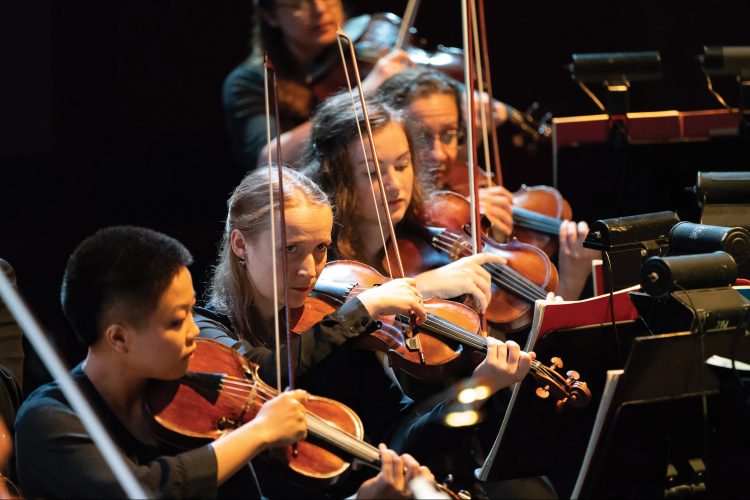
(Current EMA members and subscribers may read the complete January issue online.)
When Will Crutchfield decided to present early 19th-century operas with historical instruments and without a conductor, he anticipated musical rewards.
The new training and performance venture would involve instrumentalists in addition to the customary component of singers in a search for historically-informed performance of early 19th-century operas. Encrusted performance traditions would be removed while rethinking every aspect of the presentation. Singers, coaches, and instrumentalists would study historical vocal style, Italian poetry, ornamentation, chamber songs, and popular repertoire related to the two mainstage opera productions, Rossini’s Tancredi and Simone Mayr’s Medeain Corinto, both dating from 1813.
The major change would be the use of period instruments and historical orchestra seating, a first for 19th-century opera in the United States. Another change would involve the part dearest to Crutchfield’s heart, the Young Artist training program. Teatro Nuovo would add to its core faculty with increased language study, libretto work, intensive coaching, and “hands-on help,” said Crutchfield, while advanced singers would take leading roles in the mainstage productions.
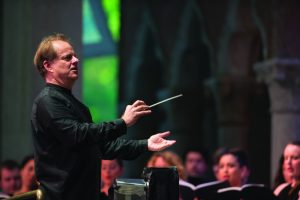
Crutchfield’s dream of instrumentalists sharing in such preparation and study of historical style has come true. The inaugural season of Teatro Nuovo at SUNY Purchase in August 2018 was a natural outgrowth of the Bel Canto program that the conductor-musicologist had spearheaded for 20 years at the Caramoor Festival in Katonah, NY. “It’s an all-professional band, though in the future we will probably integrate a mix of professionals and students when we do operas written for large orchestra,” Crutchfield said. “The exciting thing is that we are able to go through with the vision I have of an orchestra participating alongside the singers throughout the rehearsal process, taking an ownership stake in the interpretation player by player, not rushing through a few rehearsals at the last moment.“
Before the first festival, Crutchfield had expressed excitement about one element in particular. “The most radical thing we’re doing is eliminating the stand-up conductor, which didn’t exist in Italian theaters until much later. That takes a lot more rehearsing, but I’m betting it will pay off in excitement and involvement.”
In place of a conductor, duties were to be shared between a pianist—Crutchfield for Tancredi, Jonathan Brandani for Medea—and a concertmaster, Jakob Lehmann, playing from a “violino principale” part consisting of two staves, one with the actual violin part and one with vocal and woodwind cues.
Was the new-old approach a success? Crutchfield beams. “I was very pleased with the orchestral experiment, including the shared leadership. Nobody could really have known how that would work out, and there were bumps in the road to avoid next time, but it really made a positive difference. Ditto the 1816 seating plan we used. This was a revelation for me. After 25 years of doing Rossini everywhere, I now realize there are things about his orchestration I had never understood, and could only have learned by making this experiment.”
Baroque orchestras have been using historical seating arrangements for a while, but Crutchfield explains how it works for later repertoire. “Basically, the longstanding Italian tradition was a line of first violins tretching almost the length of the pit, with their backs to the audience, facing a parallel line of seconds with their backs to the stage. At the midpoint, the line is broken by the pianist, facing the stage, with the concertmaster to the pianist’s left. Most Italian theaters had a cello and a bass either behind the pianist’s back facing the stage or to his right.”
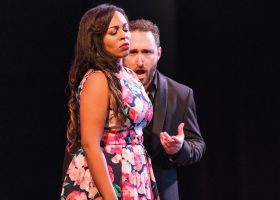
In addition, there were pairs of violas and cellos and a contrabass at either end of the pit, facing center. “So we have the bass line coming from the four points of the compass, all playing towards the center of the pit,” said Crutchfield. “And near the lip of the stage, pairs of winds, horns, and brass all facing the center of the pit. At the extremes, timpani on stage right side and bass drum with cymbals on stage left side.”
What this meant for sightlines was increased eye contact with the stage for most of the players.
“They can watch the show, and they can watch the singers breathe,” said Crutchfield. “Every player can effortlessly see the concertmaster. All but the farthest left and right first violins can effortlessly see the keyboard player. There is no way to overstate what a difference this makes for creating organic ensemble. There is following of leadership gestures, there is following the body language of fellow players, there is following of solo instruments or voices by both sight and sound, and there is that constant ‘contact with each other’ that is neither leading nor following but just being in a groove.”
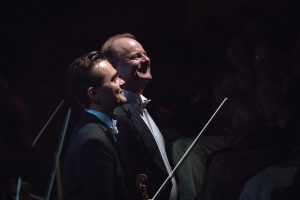
Crutchfield was amazed at the sonic blend, particularly the evenness between the string families. “Everyone can hear the bass clearly from anywhere in the band. One particular revelation for me was this: Rossini’s typical viola parts sustain harmony in long notes during much of the operas. Clumped into the middle of the band, as they always are, this is nearly unheard. Placed at the extremes, they are clearly heard throughout the hall and create an absolutely gorgeous ‘halo’ around the active parts. I had no idea to expect this. When I walked back to listen for balance the first time, I could have cried—it was just so beautiful, and in all my years of Rossini I had never heard it!”
The conductor’s practical side kicks in as he adds: “Of course, the thing that makes this scary and makes people reluctant to try it is that the far-separated violas and cellos cannot exactly hear each other. But that teaches something else we don’t usually realize. In this period, most of the music played by each instrumental family follows its own nature. First violins are playing melodies and virtuoso figurations. Second violins are playing unisons with the firsts or else accompaniment figures. Violas are sustaining harmonies or reinforcing bass or playing repeated notes along with other strings. Cellos and basses are playing bass lines. Winds are either playing block harmonies or rhythmic punctuations, or they’re playing solos. Not all the time, of course, but most of the time. All this works beautifully for the kind of music they were sitting there to play, but you never find out what that means if you don’t try it.”
Crutchfield admits that this separated seating arrangement doesn’t work for later music, but “when you have this function-based distribution, you realize that the violas do not need to ‘cohere’ as a viola section. They need to cohere with the violins and cellos near them. And if that is working on both sides of the pit, everything is working.”
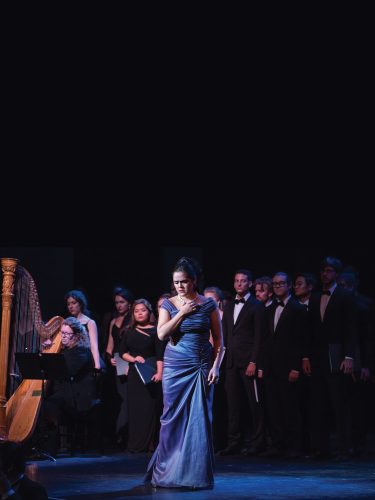
Another discovery floored Crutchfield. “We know there were keyboards in theater pits long past the age of continuo recitatives. There are pictures of Verdi conducting from a piano in the 1860s and [Michael] Costa doing so in London in 1873. We have no idea how much they actually played, and we know that with these smallish keyboards pictured the audience doesn’t really hear much of it, and they don’t need to. But the nearby players hear it. There’s actually an 1826 description explaining it just this way: that you might hear a few keyboard notes if you are sitting close, but it’s meant for the ears of the band. It’s actually irritating in recordings when they mike it into audibility. But it is still a meaningful part of the band, and a good ‘leadership instrument.’ I found I could perfectly easy provoke stringendo or a crescendo just by playing it.”
Teatro Nuovo’s principal vocal coach, Rachelle Jonck, is convinced that for a singer “the concept of ‘no conductor’ might be even more revolutionary than for the orchestral player. Today’s singers live in a conductor-driven operatic world. The prima donna is no longer the most powerful person in the opera house. Singers are taught to do as they are told. Yet the majority of operatic conductors come from a pianistic or symphonic background, and the vast majority of them are trained by those who have the same background, even in opera houses. Very few conductors are educated in how the voice functions and the skill set required from a bel canto singer.”
She elaborates. “Singers are asked to sing like instruments. In this way, Teatro Nuovo is revolutionary, because our orchestra was asked to play like singers! What a relief for a singer to hear portamenti from the strings! What a relief to be able to follow your breath through a phrase. There is no question in my mind that a bel canto line led by a singer’s voice is superior to one hinted at by a conductor’s arm.”
Like all Teatro Nuovo’s coaches, Jonck is passionate about Italian librettos and their poetic forms, “such as versi sciolti (blank verse) for the recitative and versi lirici (lyrical verse) for the arias and ensembles. Speaking text while reading from a Bärenreiter or Ricordi score does not allow a young singer to experience the libretto as verse. Only true libretto study from a properly constructed libretto allows the singer to discover lingual rhythm and poetic meter, which play an immense role in the understanding of the cadence of the language and how this interacts with the cadence of the music.”
Hannah Ludwig, who sang Isaura in Tancredi, is a perfect example. “With all the time constraints singers have, we tend to go straight to the text within the score so we can learn it all in time for the first rehearsal,” she said.
Ludwig appreciated the unhurried preparation that allowed for detailed work, particularly on the libretto. “It made a world of difference when it came to understanding the syllabic structure of the recitatives and how they should move once the notes were added. I know my text delivery in the performances this summer was more honest and sincere because of this.” As for the lack of a conductor on a podium, “it honestly felt like a chamber performance rather than a full-blown opera production. We were encouraged to listen to each other and respond rather than just park and sing. I think this festival is truly something special.”
Berlin-born violinist Lehmann has served as concertmaster of and conducted many ensembles in Europe. He was pleased with the willingness of Teatro Nuovo’s instrumentalists to embrace what he calls “some of the crazy ideas we inflicted upon them.” In addition to the novel orchestra setup, “we encouraged everyone, especially the winds, to embellish their solo passages with trills, turns, little chromatic cadenzas leading into the next paragraph, or simply adding melismatic figures to simpler musical ideas.”
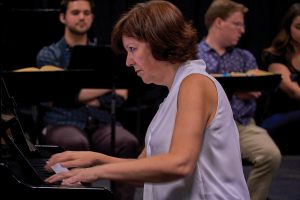
Lehmann warms to the subject: “We wanted to reestablish portamento as a vital part of our musical language, one which got lost over the course of the 20th century. I encouraged every string player to use as much portamento as possible everywhere, just to get it started. Later, we talked about where to apply it more (melodic passages, as an expressive meaning) and where to use it less (in accompaniment figures or rhythmic patterns). I ran into one of the players a few weeks ago in Amsterdam who told me, ‘Jakob, I just can’t stop sliding!’”
Looking ahead to the 2019 festival, which will feature Rossini’s La gazza ladra and Bellini’s La sonnambula, Crutchfield speaks with directness and honesty. “The early-music movement has been fantastic, a huge shot in the arm for our engagement with music from the past, a huge enrichment of the range of music we have the chance to become intimate with. But in my opinion, it has made a systemic mistake by setting itself in opposition—exaggerated opposition—to what people suppose is ‘Romantic’ or ‘big-voice’ style. I don’t believe ‘straight tone’ was ever a part of the European vocal tradition, for instance. I don’t think a female or countertenor voice without a well-developed chest register is a viable operatic instrument. I could go on, but you get the idea.
“I am much more into the continuities of the tradition than exaggeration of its changes. I don’t think Handel’s singers were ‘dainty.’ But I also don’t think Wagner’s or Verdi’s singers heaved up to their notes from a third below, or wobbled, or were unable to articulate a gruppetto. I think the bel canto revival and the early-music movement need to meet up, hopefully for the benefit of both.”
Judith Malafronte has sung with opera companies, orchestras, oratorio societies, and early-music groups internationally. A vocal coach and continuo player, she has written for Opera News and other outlets, and teaches “Shakespeare and Music” and courses in historical performance at Yale University.

